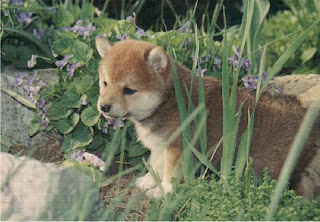It's been a whole month since the big, horrible earthquake and tsunami in Japan, but things are a long way from being back to normal in that country. So as long as we are thinking about Japan, I decided I would tell you about the most popular Japanese dog breed, which is the Shiba Inu.
Some basenji people say that shibas are pretty much like basenjis, except with more hair. But I kind of doubt that shiba people would say this, even though it's true that there are some things the two breeds share. Like for instance, both breeds are really ancient. Scientists who have looked at the DNA of shibas say that this breed goes all the way back to the 3rd century B.C.
What happened in the beginning was that dogs were brought to Japan from China, and these dogs were probably chow chows. Then, during about two thousand years, six different breeds of Japanese dogs were created from these first dogs. The shiba inu is the smallest of these. They were bred to hunt and flush birds and small game, and they are really good at climbing on steep hills and rough mountain slopes.
In Japanese, the word inu means "dog." Shiba means "brushwood," and especially one type of shrub that turns red in the fall. No one is sure why "brushwood" is part of this dog's name, but maybe it was because the dogs hunted in these types of bushes. Or maybe it was because the dogs can be a red color, like the leaves. And also the word shiba means "small" in the Nagano dialect. So a Shiba Inu is a "Little Brushwood Dog."
Shibas can be any color, but the most common colors are red or black-and-cream. The male shibas weigh about 23 pounds, and the females weigh about 17. They have a thick, double coat, and a tail that curls over their backs. Shibas live to be about 12 or 15 years old. They sometimes have genetic health issues such as hip dysplasia, luxating patellas, allergies, glaucoma, or progressive retinal atrophy.
If shibas are really unhappy or annoyed, they do something called the "shiba scream." This scream is very high-pitched and loud. Basenjis can shriek or scream, too, so this may be the same sort of sound that shibas make. Mom says this sound is "unnerving," but I like to think of it as "expressive" if you are trying to get your point across. Personally, I'm a very good shrieker, and this talent comes in handy from time to time. But getting back to shibas, they sometimes also scream when they are happy, like when their human comes home after being gone for a long time.
Another way that basenjis and shibas are similar is that we both like to keep ourselves clean and tidy by licking ourselves, sort of like cats do. But unlike basenjis, shibas like to swim and they also play in mud puddles. This seems like totally bizarre behavior to me, so don't ask me to explain it.
Shiba inus are alert, intelligent and very independent, so it can be harder to teach them all that obedience-type stuff. Also shibas are sometimes dog-aggressive, especially with a dog of the same sex. So shiba owners have to be careful when their dogs are around other dogs. But if shibas are socialized a whole bunch starting from when they are puppies, there won't be so many problems of this type.
During World War II, shibas almost became extinct because a lot of them were killed in bombing raids, and then there was a distemper epidemic after the war. Over the centuries, shibas got bred to other types of dogs, but the breed stayed mostly pure in rural parts of the country. So eventually, three surviving bloodlines were used to make one strong breed again.
The first Japanese breed standard for the shiba was published in 1934. And in 1936, the dog was declared a National Treasure of Japan. Then in 1954, an Army service family brought the first shiba to the United States. The AKC recognized the shiba inu in 1992 and added the breed to the Non-Sporting Group in 1993. Nowadays, the shiba isn't used for hunting. It's just kept as a pet in Japan and other countries.
We sometimes see shiba inus around here, like right in our own neighborhood. And yesterday, Mom was surprised to see one in the clinic waiting room at the shelter. She even went and asked the dog's mom if it was a shiba, just to make sure.
So you never know where a shiba inu will show up, just like you never know where a basenji will show up. We cute little ancient breeds really get around!






No comments:
Post a Comment